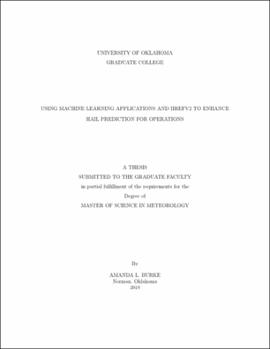| dc.description.abstract | In this thesis, I demonstrate how hail prediction can be improved through post-processing numerical weather prediction (NWP) data from the new High-Resolution Ensemble Forecast system version 2 (HREFv2) with machine learning (ML) models. Multiple operational models and ensembles currently predict hail, however ML models obtain optimal predictions that are computationally efficient and do not explicitly predict hail. Additionally, ML models can synthesize multiple datasets, which helps address the abundance of ensemble data that can lead to cognitive forecaster overload. The observational dataset used to train all of the ML models is the maximum expected size of hail (MESH), a Multi-Radar Multi-Sensor (MRMS) product.
Random forest models, along with a calibration step using isotonic regression, produce severe hail predictions over the contiguous United States (CONUS) with probability magnitudes similar to operational forecasts. Calibrating the ML-based predictions toward familiar forecaster output combines higher skill from the ML predictions with forecaster trust. Verification suggests that the calibrated ML models maintain spatially similar regions of severe hail while providing similar hail probability magnitudes, as compared to the SPC day 1 hail outlook and practically perfect data. The ML output calibrated towards the local storm reports exhibited better or similar skill to the uncalibrated predictions, while decreasing model bias.
In addition to CONUS hail forecasting, I investigate the superiority of localized forecasting by regionally training ML models in high-impact hail environments. Objective, subjective, and statistical verification indicates the southern plains ML model produces superior hail forecasts over the CONUS-trained ML model. Moisture fields are emphasized in the southern plains region, with additional instability and shear variables displaying importance, similar to the CONUS-trained model. A larger training dataset spanning multiple years, as well as exploration into different regional weighting functions, could improve the other locally trained ML models. | en_US |
